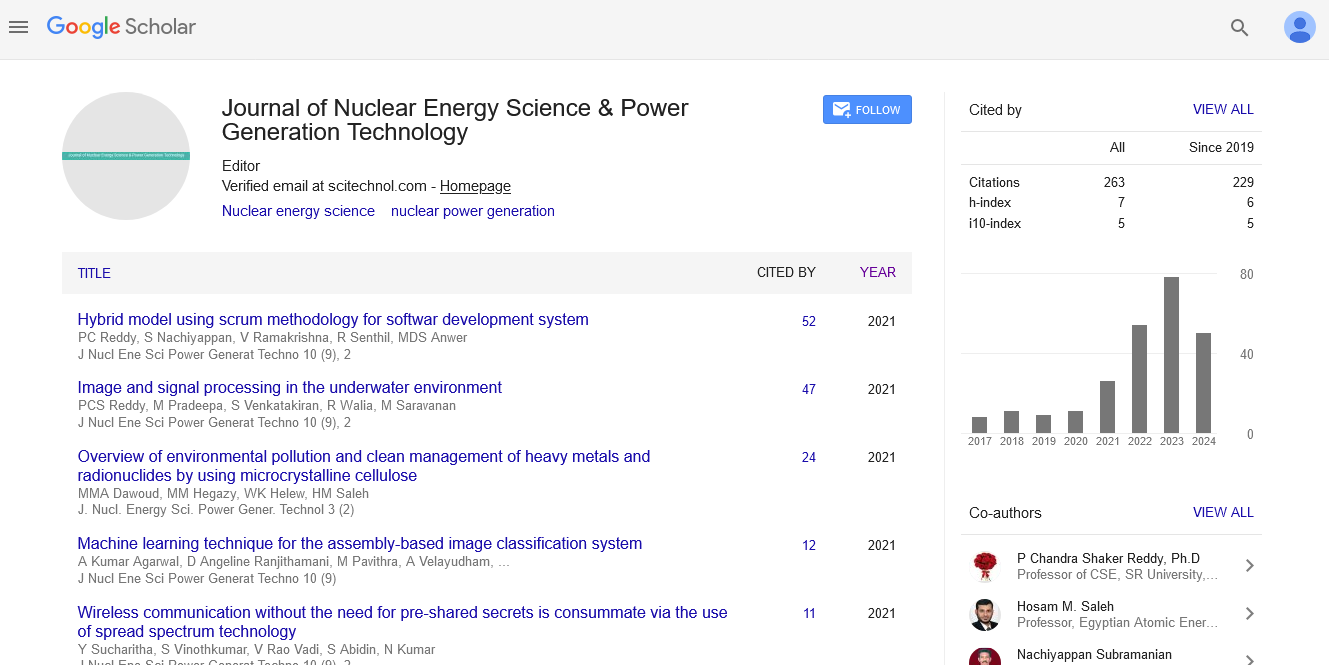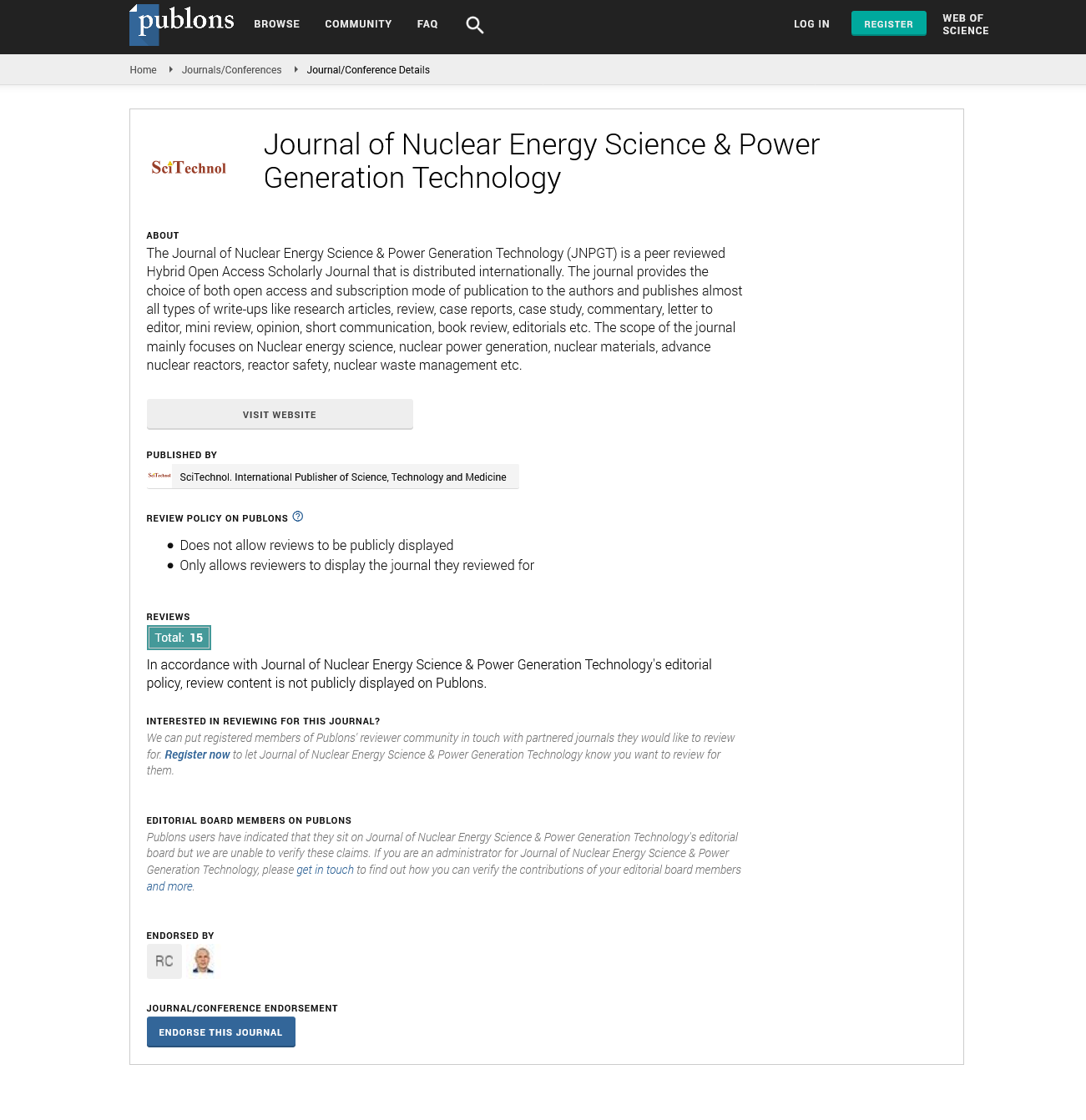Commentary, J Nucl Ene Sci Power Generat Technol Vol: 13 Issue: 5
Atomic Energy: Utilizing the Power of an Atom for a Sustainable Future
Uriasi Gheisa*
1Department of Physics, Ege University, Izmir, Turkey
*Corresponding Author: Uriasi Gheisa,
Department of Physics, Ege University,
Izmir, Turkey
E-mail: uriasi_gheisa11@gmail.com
Received date: 26 August, 2024, Manuscript No. JNPGT-24-150410;
Editor assigned date: 28 August, 2024, PreQC No. JNPGT-24-150410 (PQ);
Reviewed date: 11 September, 2024, QC No. JNPGT-24-150410;
Revised date: 18 September, 2024, Manuscript No. JNPGT-24-150410 (R);
Published date: 25 September, 2024, DOI: 10.4172/2325-9809.1000414.
Citation: Gheisa U (2024) Atomic Energy: Utilizing the Power of an Atom for a Sustainable Future. J Nucl Ene Sci Power Generat Technol 13:5.
Description
Atomic energy also known as nuclear energy is one of the most powerful and efficient sources of energy available today. It is derived from nuclear reactions that release vast amounts of energy by splitting atoms in a process known as nuclear fission or by combining atoms in nuclear fusion. With its ability to produce large-scale electricity with minimal greenhouse gas emissions atomic energy maintains significant potential as a clean and reliable energy source, to combat climate change. In nuclear fission, neutrons are fired at the nucleus of a heavy atom causing it to split into smaller fragments. This reaction releases additional neutrons, which can cause more fission reactions in a self-sustaining chain reaction. The heat generated in this process is used to convert water into steam, which initiate turbines to produce electricity in nuclear power plants. Unlike fission, nuclear fusion involves combining light atomic nuclei, such as hydrogen isotopes to form heavier elements. Fusion reactions occur naturally in stars including the Sun. While fusion has the potential to provide virtually limitless energy, the technology to control fusion reactions for power generation is still in the experimental phase.
Components of a nuclear power plant
The core contains fuel rods made of enriched uranium or plutonium along with control rods that regulate the fission process by absorbing excess neutrons. The heat generated in the reactor core is transferred to a coolant, typically water or gas, which circulates through the reactor to prevent overheating and transport the heat to the steam generator. The heat from the coolant is used to convert water into steam, which then initiate turbines to generate electricity. Nuclear power plants are equipped with robust containment structures that house the reactor and other critical components, designed to prevent the release of radiation in the happening of an accident. Nuclear power plants produce negligible amounts of carbon dioxide and other greenhouse gases during operation, making them one of the cleanest energy sources. This is significant in the fight against climate change, as reducing emissions is a top priority for many countries. The amount of energy produced by nuclear reactions is significantly higher than that produced by fossil fuels. A small amount of nuclear fuel can generate vast amounts of electricity, making it a highly efficient energy source.
Despite these challenges, nuclear energy remains an important part of the global energy mix, particularly as the world transitions to lowcarbon energy systems. Innovations in nuclear technology, such as Small Modular Reactors (SMRs) and Generation IV reactors, are method for safer, more efficient and flexible nuclear power systems. SMRs are smaller and more flexible than traditional nuclear reactors. They provide advantage of lower upfront costs and shorter construction times making them more accessible to countries and regions with limited energy infrastructure. SMRs also provide enhanced safety features such as passive cooling systems that reduce the risk of accidents. These advanced reactors are designed to improve the efficiency of nuclear fuel use and reduce the production of longlived radioactive waste. Some Generation IV designs also incorporate passive safety features and are capable of operating at higher temperatures which enhances electricity generation efficiency.
Conclusion
Atomic energy is a powerful and sustainable energy source with the potential to perform a major role in addressing the world’s growing energy needs while reducing carbon emissions. While challenges related to safety, waste disposal and costs persist, technological innovations and stricter regulations are helping to overcome these hurdles. As the world transitions towards a low-carbon future, atomic energy will possible remain an essential component of the global energy mix, contributing to a cleaner, more sustainable future. Fusion has the potential to provide a virtually limitless supply of energy with minimal environmental impact.
 Spanish
Spanish  Chinese
Chinese  Russian
Russian  German
German  French
French  Japanese
Japanese  Portuguese
Portuguese  Hindi
Hindi 

